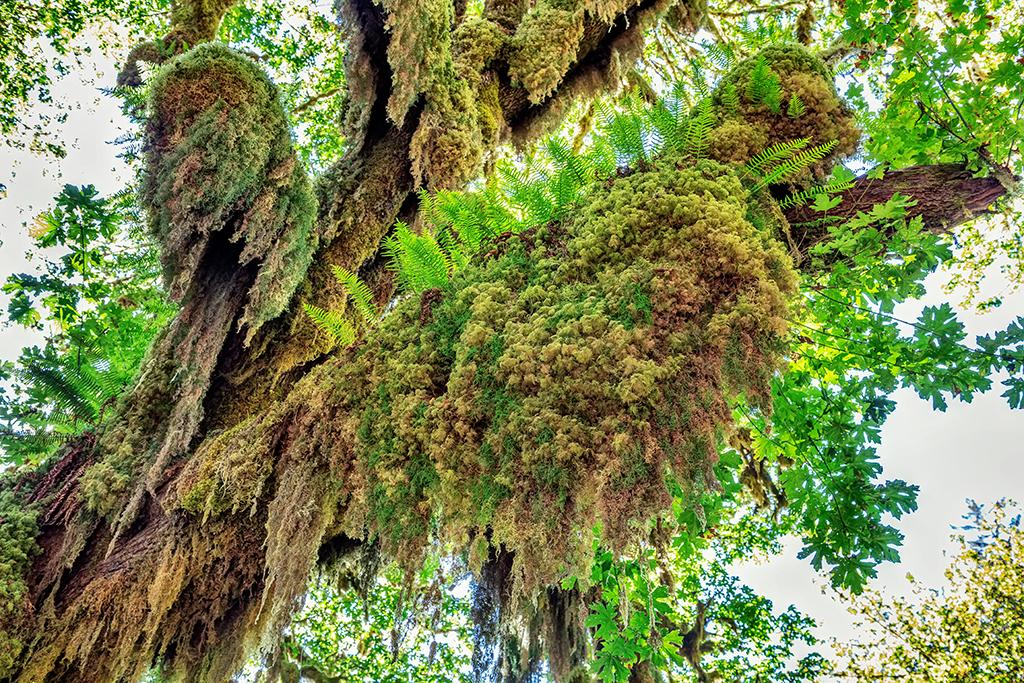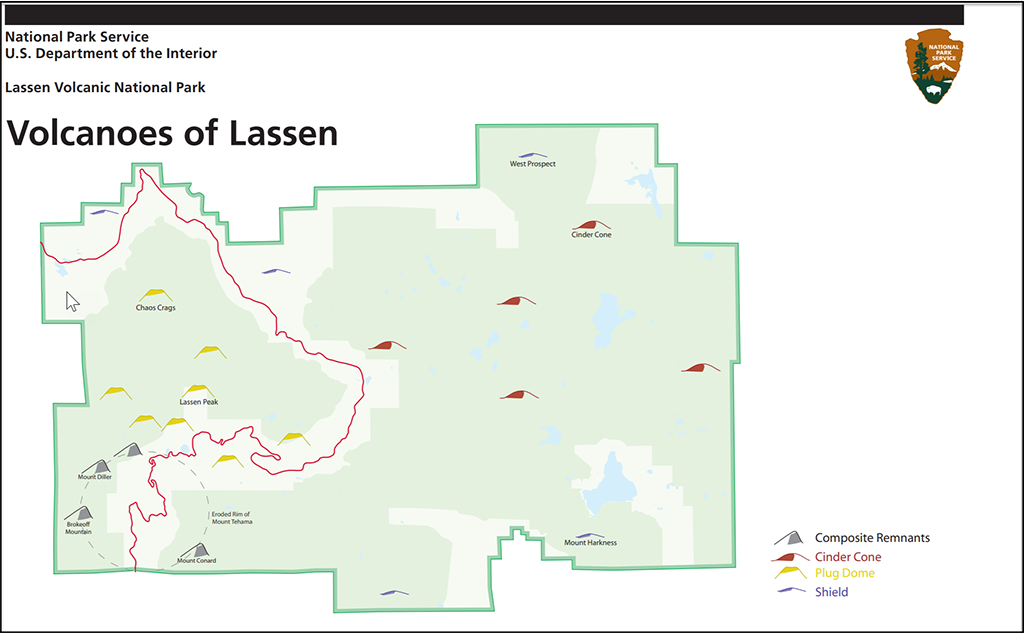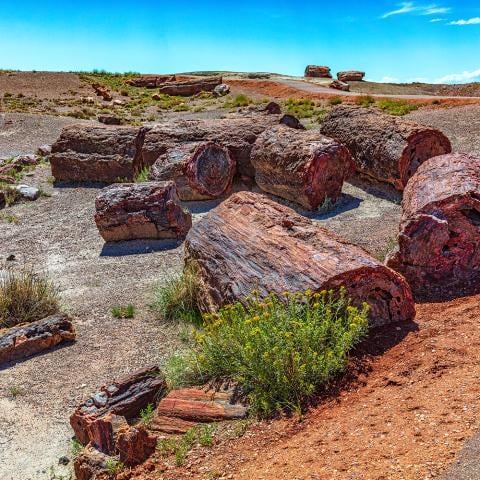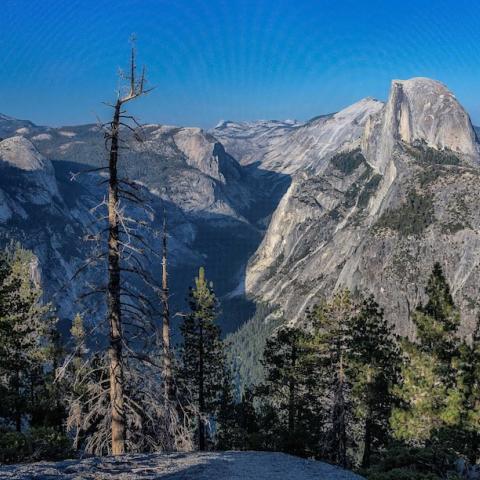
Licorice ferns and bigleaf maple in the Hoh Rain Forest, Olympic National Park / Rebecca Latson
I recently received my book Scenic Science of the National Parks, by Emily Hoff and Maygen Keller. Not too long ago, the Traveler interviewed these two authors for Podcast #51. I love learning about the things I photograph when exploring national parks, and I was pleased and proud to discover some of my photographs highlight information mentioned in their book. So, for National Parks Quiz and Trivia #6, I thought I’d use material found in Scenic Science of the National Park. Remember, test your national parks knowledge first, before checking the answers at the bottom of the page.
1. Epiphytes (plants that grow on plants) are found all over the trees of Olympic National Park. They include mosses, lichens, liverworts, and ferns. They get everything they need to survive “from dripping water and nutrients blowing in the wind.” How many species of epiphytes – thus far – have been identified in this national park?
a) 300
b) 130
c) 250
d) 425
2. In Joshua Tree National Park, you’ll probably see a kangaroo rat burrow or two during your foray into the desert. True or false: kangaroo rats don’t need to drink water to survive out there.
a) True
b) False

Blooming ocotillo and the Chisos Mountains, Big Bend National Park / Rebecca Latson
3. If you visit Big Bend National Park in Texas, you’ll be wandering through the volcanic Chisos Mountains and the dry Chihuahuan Desert. In the desert portion of the park, you’ll see lots of tall, spindly, thorny ocotillo. True or false: the ocotillo is a cactus.
a) True
b) False
4. Kings Canyon is one of the deepest canyons in the United States. How much deeper is it than the Grand Canyon?
a) 900 ft
b) 1,000 ft
c) 2,000 ft
d) 3,000 ft
5. What national park was featured in the movie Return of the Jedi?
b) Rocky Mountain National Park
c) Redwood National and State Parks
d) Mount Rainier National Park

Giant Kelp, Channel Islands National Park / NPS - Kelly Moore
6. Channel Islands National Park protects five islands and surrounding seawater off the coast of Southern California. Looking into (or under) the water you’ll see “forests” of giant kelp (Macrocystis pyrifera). True or false: kelp isn’t a plant.
a) True
b) False

A male green sweat bee, Pinnacles National Park / NPS - Paul Johnson
7. A visit to Pinnacles National Park during the spring and summer guarantees you all sorts of flower and insect sightings, particularly bees. Most of us think of only two kinds of bees: bumblebees and the slightly-less-hairy honeybees. In truth, there are quite a few bee species found in this national park, including the wasp-looking cuckoo bee and the green sweat bee. Approximately how many bee species have been found in this national park?
a) 100
b) 200
c) 300
d) 400

An ancient, cross-bedded sand dune, Zion National Park / Rebecca Latson
8. Take a look at the cross-bedding in the photo above of an ancient, lithified (transformed into stone) sand dune in Zion National Park. In which direction was the wind current predominantly blowing?
a) Toward the right
b) Toward the left
9. Lechuguilla Cave, in Carlsbad Caverns National Park, is the deepest limestone cave in the United States. True or False?
a) True
b) False
10. The Guadalupe Mountains of Guadalupe Mountains National Park were created from:
a) Tectonic plates crashing into each other
b) Subducting tectonic plates (plates sliding underneath the North American plate)
c) Stretching and thinning of continental crust
d) An ancient limestone reef
And now, here’s a little bit of trivia for you
Lichens are found in many places, including Yosemite National Park. One type that you’ll see in this national park is a bright yellow-to-yellow-green lichen called Candelaria pacifica. Its presence indicates an excess of nitrogen in the air. “Excess nitrogen can produce pollutants, like ammonia and ozone, make it difficult for us to breathe, and alter plant growth,” according to www.epa.gov. So, this particular type of lichen, at least, is sort of like a canary in a coal mine, warning of potentially harmful things that are invisible to us.

Volcanoes of Lassen Volcanic National Park / National Park Service
At the south entrance to Lassen Volcanic National Park, the park highway cuts through the middle of what used to be an 11,000-foot-high stratovolcano called Mount Tehama. Precipitation, glaciers, and hydrothermal activity eroded this mountain away so that only remnants survive now, in the form of Brokeoff Mountain, Mount Diller, Pilot Pinnacle, and Mount Conard. You can learn more about the volcanoes of this national park here.

The many colors of petrified wood, Petrified Forest National Park / Rebecca Latson
Look closely at the colors of the petrified log section in the photo above, captured in Petrified Forest National Park. These colors were created by “trace amounts of minerals in the water and changing conditions over time.” The yellow, brown, and orange colors were created from an oxidized iron mineral called goethite, also called yellow or brown ochre. The black you see in this section may come from pyrite (fool’s gold) created by sulfur interacting with iron in the decaying organic matter, or manganese dioxide. The white is silicon dioxide (quartz or “sugar agate,” as my Granny used to call it). Purple (and black) comes from manganese dioxide; “water traveling through volcanic rocks leaches manganese and redeposits it as a concentration of manganese dioxide inside the trees.” The red color comes from the mineral hematite, which “usually forms when iron in groundwater reacts (rusts) with the oxygen inside tree trunks.
Quiz Answers
1) b
130 species have so far been identified in Olympic National Park. The next time you are wandering along the Hall of Mosses Trail in the Hoh Rain Forest, look up and see if you can spot the leaves of the bigleaf maple. Then, look at the “finery” festooning the maple’s tree branches. You might see bright green, delicate ferns dancing in the breeze. Those are licorice ferns and they really *do* taste like sweet licorice … if you like licorice, that is.
2) a
Kangaroo rats can metabolize the moisture from seeds they store in their cheek pouches and thus don’t need a direct water source. And, when they pee, it’s “a super-concentrated urine that some scientists describe as pasty or crystal-like.”
3) b
Even though the ocotillo has evil-looking thorns, it is a shrub. When there is enough moisture in the soil, ocotillos sprout leaves from the base to the tips of their spindly branches. Those branches can reach up to 20 feet tall. The leaves don’t last long, though. In the spring, you’ll see clumps of bright orange-red flowers at the tips of these branches that are quite attractive to hummingbirds.
4) c
Kings Canyon is 2,000 ft deeper than the Grand Canyon.
5) c
Due to its lush, untouched scenery and tall trees, Redwood National and State Parks was featured in Return of the Jedi (the forest moon of Endor).
6) a
Kelp is not a plant but a type of algae. The parts of giant kelp that remind us of plant parts don’t have the same names as plants’ parts, nor do they serve the same purpose. What we think of as roots are called “holdfasts” which don’t transport water or nutrients, but instead serve to keep the kelp anchored. What we think of as a stem is called a “stipe,” but instead of transporting nutrients, stipes form a support system to help the kelp bend with the constant back and forth motion of the waves. What looks like leaves are called “blades” and they capture sunlight for photosynthesis and absorb nutrients from the seawater. Around the blades are gas-filled bladders that help keep the plant afloat. Giant kelp can grow “more than one hundred feet tall, about twice as tall as the letters on the famous HOLLYWOOD sign.”
7) d
400+ bee species have been found in Pinnacles National Park. “More than two hundred fifty species of bees have been spied on Old Pinnacles Trail alone!” Those cuckoo bees mentioned in the question are known as kleptoparasites, meaning they lay their eggs in another species’ nest. You can bet what happens to the original host’s eggs, can’t you?
8) b
About 200 million years ago, what is now Zion National park was part of an area larger than Montana, covered with desert sands in “conditions nearly identical to the modern Sahara.” The sand dunes were “tall enough to bury the Statue of Liberty.” When determining the direction that the wind (or water) current moved the sand grains, remember that the steep side tilts in the direction of the prevailing water or wind current. Sand grains collect up to a certain height (peak) called the “angle of repose” and then they start tumbling down the dune (the lee side) to create the curved lines you see in the cross-beds. So, in the case of the photo, the sand was mainly blowing toward the left of the image.
9) b
Lechuguilla Cave, in Carlsbad Caverns National Park, was considered the deepest limestone cave in the United States until the exploration of Tears of the Turtle Cave, in 2014, located in the Bob Marshall Wilderness of western Montana. So, Lechuguilla Cave is the second-deepest limestone cave, and one of the four longest caves in the U.S.
10) d
The Guadalupe Mountains “are the eroded and uplifted remains of a limestone reef built near the shore of an ancient sea.” The Cascades were created from tectonic plates crashing into each other, the Rockies are mountains made from “bizarrely subducting plates,” and the mountains you see in Nevada were made from the stretching and thinning of continental crust. This, of course, is the basic answer, which doesn't include all the complexities involved in the creation of each of these mountain ranges.




 Support Essential Coverage of Essential Places
Support Essential Coverage of Essential Places







Comments
Great quiz!! Love all of the pertinent information.